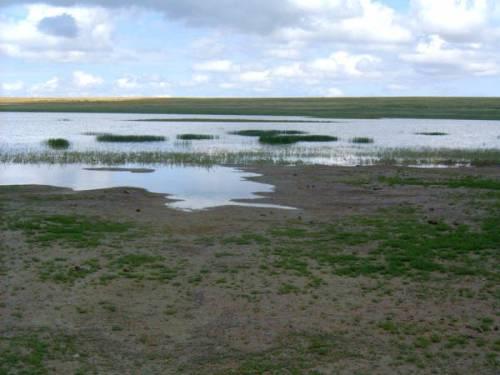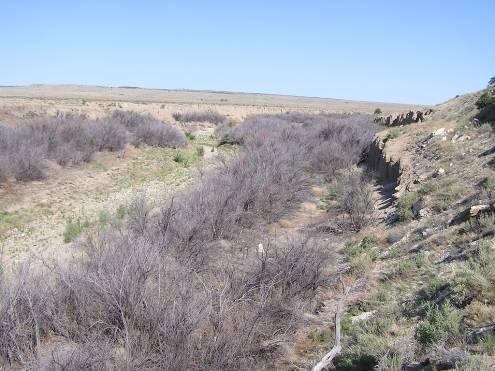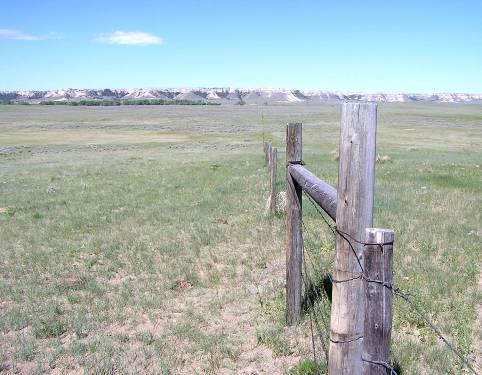|
Habitat Enhancement Projects
|
[ ]
|
Playa Restoration
Playas are variably sized depressions in the prairie that are usually dry. However,
during wet periods, especially after heavy thunderstorms, these depressions are
often filled with water and teeming with birds. Playas provide nesting, feeding,
or resting grounds for an abundance of waterfowl, wading birds, and shorebirds.
Common conservation practices include fencing playas to better manage grazing efforts,
providing alternate water sources, and filling pits adjacent to or within playas
to restore the native hydrology of the basin.
Grissom Playa Restoration, Las Animas County, Colorado
In June of 2005 the landowner filled a 1400 cu. yd. pit in the playa basin in an
effort to restore the natural hydrology of the playa. The disturbed area was re-seeded
to a native warm season shortgrass mix. In August 2006, a 21,000 gallon storage
tank was installed to provide alternate water storage/ source for the livestock
grazing operation. The landowner will continue a rotational grazing system with
the playa basin being deferred for one year.

|

|

|
|
Playa pit before filling, 2005
|
Playa pit after filling, June 2006
|
Wet playa after rain, August 2006
|
Riparian Restoration
Riparian areas are essentially the narrow strips of land that border creeks, rivers
or other bodies of water. Because of their proximity to water, plant species and
topography of riparian zones differ considerably from those of adjacent uplands.
Although riparian areas may occupy only a small percentage of the area of a watershed,
they represent an extremely important component of the overall landscape. Benefits
of a healthy, functioning riparian area include improved water quality and flow,
erosion control, improved fish and wildlife habitat, and better livestock forage.
Common restoration techniques for riparian areas include fencing, managed grazing,
providing alternate water sources for livestock, shrub or tree planting, and stream
bank stabilization.
Bartlett Ranch Riparian Project, Goshen County, WY
In 2004, a riparian restoration project was initiated along a portion of Rock Creek
in Goshen County, WY. The project included fencing of the riparian area, managed
grazing to control cheatgrass, development of alternate water sources, cottonwood
plantings, and reseeding of an adjacent upland pasture.

|

|
|
Fox Creek riparian area, May 2004
|
Fox Creek riparian area, June 2007
|
Noxious Weed Treatment
Noxious weeds and other exotic plants frequently outcompete native vegetation, once
established. Negative impacts include loss of natural cover and forage for wildlife
and livestock, decreased native plant diversity, decreased stream flow in riparian
areas, and altered wetland hydrology.
Depending on the type of weed and the degree of infestation, a number of methods
may be used to control exotics, including herbicide spraying, mechanical treatment,
prescribed burning or grazing, or re-vegetation with native species.
Apishapa Canyon Ranch Tamarisk Removal Project, Pueblo/Las Animas Counties, CO
Habitat restoration along the Apishapa River was implemented to enhance the riparian
corridor for native wildlife as well as make water more readily available for wet
meadow habitat and stream flow. Aerial treatment of 160 acres of tamarisk using
Habitat® occurred September 2005. Plants showing re-foliation will be treated with
a backpack sprayer and the remaining woody debris from the dead plants will ultimately
be removed.

|

|
|
Aerial spraying of tamarisk, 2005
|
Treated tamarisk, 2007
|
Grassland/Grazing Management
Managed livestock grazing can improve the amount and diversity of habitat available
for grassland birds and other wildlife species. Managed grazing also gives producers
more flexibility in their operations allowing selected pastures or portions of a
ranch to be rested sufficiently to produce desired forage quality and quantity.
Good private rangeland management is essential to Great Plains wildlife as over
80% of the region is privately owned.
Probably the single most important aspect in good range management is selecting
the proper stocking density for the given range condition. Tools that can be used
to control the timing of grazing and distribution of livestock include fencing,
water development, herding, and prescribed burning. Natural resource specialists
can work with producers to develop systems that will meet the needs of wildlife
without compromising the profitability of a ranch.
Smith Ranch Project, Goshen County, WY
In 2004 work was initiated on the Smith ranch in Goshen County, WY. Cross-fencing
was installed to allow better management of grazing during the calving season. A
solar powered pump was also installed to provide water for the new pasture system.
Annual photo monitoring and bird counts show positive responses to the new grazing
system.

|

|
|
Smith ranch cross-fencing
|
Solar water pump in new pasture
|
Native Grass and Forb Plantings
Native rangelands provide the best habitat available for grassland birds in the
Great Plains because they provide the plant communities that native bird species
evolved with. Rangelands that have been converted to agriculture or altered in other
ways can be improved or restored with native species plantings.
Conservation Reserve Program fields can be improved for birds by interseeding forbs
and legumes into grass stands. RMBO's Stewardship Division is working on a project
in Southeast Colorado aimed at improving nesting and brood rearing habitat for Lesser
Prairie-Chickens on CRP fields. Landowners with CRP fields in close proximity to
active prairie chicken leks are being recruited to participate in the voluntary
interseeding program with the goal of improving 500-1000 acres of habitat within
Lesser Prairie-Chicken range.
|